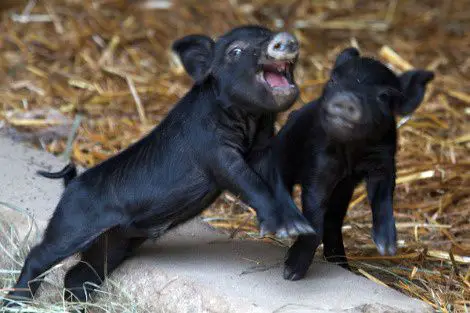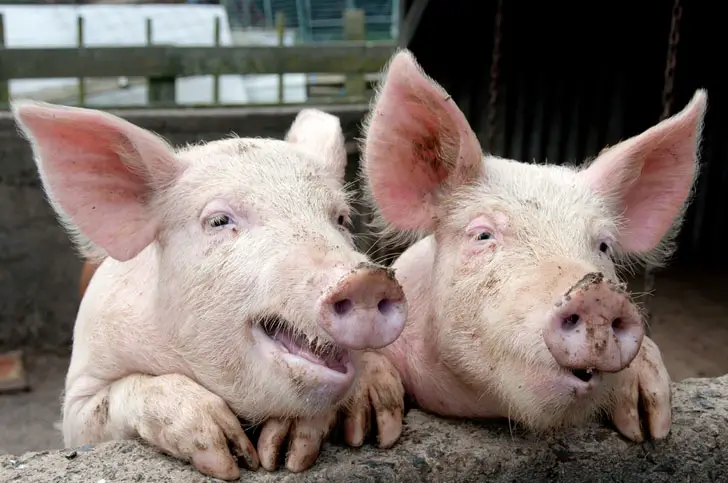Many people are unfamiliar with a pig’s behavior and most of them are also misled by how the media and other people portrayed pigs. We want to help clear the stigma in pigs by writing a helpful guide about pigs.
How do pigs communicate? Pigs communicate through body language, vocal communication and through scent. Humans cannot really pick up scent signals the way some animals do which is why we mostly focus on body language and vocal communication.
People may think that pigs are harder to understand than cats and dogs or other common animals that we know, but pigs are actually one of the most expressive animals you can ever come across with.
A pig’s body language alone already speaks volumes.
The most common body language we observe in pigs is tail wagging, erected ears, fast running, smiling and nudging.
For vocal communication, we can usually hear pigs oinking or grunting. Just like people and other animals, what they want to deliver may depend on their tone of voice.
Some pigs are not as vocal as the others. They are usually quiet animals and only vocalize themselves around fellow pigs.
Young piglets tend to be more vocal than adults because they are still young and do not really know how to deliver their body language.
There are times when pigs oink as loud as they can to send a “warning signal” to nearby people or animals.
When you hear your pig grunting, know that it’s not just a grunt. Most animals don’t make noises for the sake of nothing. They’re always trying to communicate when they make sounds.
Always pay attention to your pig in order to get to know them. Pigs can have individual personalities apart from their breed’s temperament and may behave differently which means they can communicate differently.
So how can we tell what our pig is trying to tell us? It’s important to know the meaning behind our pig’s actions in order to fully understand them.

How pigs communicate through body language
We rely solely on a pig’s body language to determine what they are trying to tell us and make us understand.
Most animals have a really short range of options to express themselves but pigs can find ways to go beyond their limitations.
Some owners can really find it surprising how a pig behaves!
The reason behind this is because pigs are incredibly intelligent creatures. Pigs ranked fifth among the most intelligent animals in the world, can outsmart dogs and chimpanzees and are said to have the same intelligence level as a 2 year old child.
Being pretty clever, pigs can think of methods to communicate better through body language. Below are some more of their common body language and behavior.
- Tail wagging
- Nudging or Rooting
- Digging
- Charging
- Being stubborn
- Biting
- Rolling
- Playing with food
- Pushing
- Hiding
- Crying
- Smiling
1. Tail wagging — is a sign of happiness, excitement, contentment. Some pigs have their tails docked and may not be able to control their tails anymore.
2. Nudging or Rooting — rooting is a very common behavior among pigs because they have poor eyesight. They rely on their sensitive hearing and excellent sense of smell to analyze objects.
When a pig nudges you with their nose, it should not be confused with aggressive behavior. They are simply trying to examine you, familiarize with you or sometimes just asking for your attention.
3. Digging — can be a sign of hunger, boredom, playfulness or it can mean your pig can smell food or hear something that captures their interest in the specific area they are digging at
4. Charging — might be a sign of fear, aggression, dominant behavior but can also be a hint of desire to play
5. Being stubborn — is a sign of protest or showing you their grudge, can also be a sign of showing dominance and an attempt to establish a manipulative behavior
At times it can also be a sign of being spoiled, or a way to humor owners if pigs are conditioned to think stubbornness is “cute” or “adorable”
6. Biting — is a sign of aggression, dominant behavior but can also be due to fear and shock. Biting should not be tolerated and must be corrected.
Read our article about how to discipline a pig.
7. Rolling — is a sign of feeling filthy, they may want to tell you they want to cool off or bathe, it can also possibly mean they are being playful and want to show it by rolling around.
Sometimes it means they might want to play outside, or in mud
8. Playing with food — some pigs play with their food to let you know they didn’t like it or they don’t want too much of it, sometimes it’s just a part of their mischievous personality
9. Pushing — when pigs push you or other animals in the house, sometimes they want to show dominance. Other times it could mean they are being competitive, showing grudges or exhibiting aggressiveness.
Often times they do it to ask for attention.
10. Hiding — is a clear way of showing you they are afraid, they are prey animals and can easily be terrified. Depending on the situation, it can also be a sign of playfulness.
12. Crying — pigs can cry real tears when they are mourning, but they do not cry out of joy. When a pig cries, it should be important to comfort them.
13. Smiling — is a clear sign of happiness! Pigs can smile and they look really adorable when they do it.
If you want to learn more about a pig’s smile, you can read our article “Do Pigs Smile?”
There are more ways of how pigs can communicate through body language so read on to find out!

How pigs communicate through affectionate behavior
Pigs are usually social animals but it is not uncommon for them to hide away from physical contact such as cuddling or being held and carried.
Sometimes, they are not used to such gestures and may perceive it as a hostile action that they must avoid.
Depending on your pig’s personality, they may react differently towards different actions.
But how do pigs show affection, not just communication?
Below are the common ways for pigs to show affection.
Snout kissing
Snout kissing is basically just kisses, but since they have large noses, their nose touches us first before their mouths can even do.
Sometimes, it can be plain “nudging” but when they do it for continuous seconds while wagging their tails, it can be considered “snout kissing” which means they love you as their companion!
Licking
Licking may be rare for most pet pigs, but they can still do it as a form of “kissing” too. “Grooming” is not part of a pig’s normal behavior therefore it cannot be perceived as such.
Apart from licking, they can also gently try to nibble on you.
Such actions could mean they are simply being affectionate and should not be immediately judged as negative behavior.
Cuddling and Lap visits
Pigs that are fond of you and grown completely attached to you may come to you on their own for lap visits! It can be a thrilling experience especially if you encounter it for the first time.
Some may also enjoy cuddling and you may see them have a smile on their faces as they cuddle with you.
This is a clear sign of love!
How pigs communicate through vocal expression
There is not much we can tell from a pig’s vocal tone, but there are a few clear signs that can help us understand them better. There are different kinds of “grunts” which can also be called “oinks” depending on your pig.
- Calm grunts — might be trying to get your attention
- Continuous grunts — needs something, trying to warn, may be annoyed, bored or feeling lonely
- Low, sad toned grunts — can be a sign of crying, grieving, mourning, loneliness, or in pain
- Loud grunts — may be trying to warn, can be a sign of excitement, trying to show dominance, expressing anger or displeasure
- Crying grunt — sign of depression, sickness, loneliness, sadness, pain
Every pig may have different personalities and their tones may differ all the time. As long as you are familiar with your pig’s personality, understanding them can be easier.
What pigs try to say through uncommon behavior
There are times when pigs may exhibit behavior that is not seen among other pigs and can raise curiosity and serious concern for some. Here are some uncommon behaviors that you need to look out for.
Continuous crying
If you have no idea why your pig won’t stop crying and there is no reason for them to be depressed, sad, grieving or such, there might be an underlying problem that we are not aware of.
Pigs cannot speak our language but they can behave the same way as a baby that cries because it is the easiest way to tell us something they can’t.
Non-stop crying can be a sign of hidden illness or pain for pigs that our naked eyes cannot see.
If you suspect unusual behavior in your pig, consult your veterinarian.
Threatening violence
Naturally, pigs are gentle and peaceful animals but if they exhibit aggressiveness, it can be dangerous especially if they are large and have tusks that can be deadly.
A pig that cannot be disciplined or continues to show alarming and disturbing behavior could be a victim of mistreatment, abuse or trauma and needs deeper understanding in order to find out how to fix them.
If you suspect your pig is starting to become threatening, consult an expert.
Wall licking or self-harming
If there is nothing to lick on the wall and yet your pig continues to do so, it might be a sign of sickness.
When a pig harms themselves, it can be a clear sign of depression and must be treated as soon as possible.
Pigs are capable of doing the following self-harm methods
— banging their heads against concrete
— refusing to eat and refuses force feeding
— jumping off high areas
— intentionally getting themselves sick
— intentionally putting themselves in danger
Pigs are smart animals and they can do a lot of things that may surprise us. They have many ways to express and communicate which is why we must also be careful and understanding towards them.
Related Questions
- What happens if a pig bites you?
Just like other animal bites, a pig’s bite can become threatening if it manages to break the skin and leave marks or wounds. The mouth is one of areas that can be full of bacteria.
The bitten area can easily be infected by bacteria and may further develop into a dangerous disease and must be treated immediately.
Regardless if the pig has been vaccinated or received all their medical treatments, a bite should not be taken lightly if it caused a wound.
Pigs must be disciplined properly in order to stop biting.
Read about: “Do Pet Pigs Bite?”
- How old does a pig need to be to breed?
Most breeds of pigs can become sexually mature at five to six months old.
However, a breed called “Meishan” pigs can become sexually mature at around 2 to 3 months of age which is exceptionally earlier than other pigs.
Pigs have high success in pregnancy and birth rates and some can produce high amount of liters while some can only produce a few.
If you would like to learn more about breeding, you may read our article about it here.
